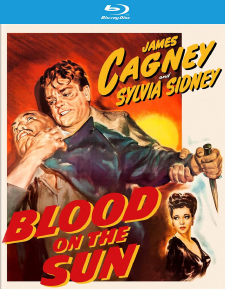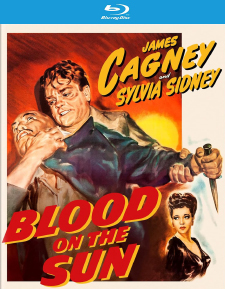Blood on the Sun (Blu-ray Review)

Director
Frank LloydRelease Date(s)
1945 (February 13, 2024)Studio(s)
United Artists (Kino Lorber Studio Classics)- Film/Program Grade: B
- Video Grade: A
- Audio Grade: A
- Extras Grade: C+
Review
Blood on the Sun, made in 1945 but set in in 1929, combines history and fiction in a drama purporting to show how politics and a questionable document laid the groundwork for the Japanese attack on Pearl Harbor on December 7, 1941.
Referred to in the opening crawl as the “Oriental Hitler,” Tanaka Giichi was a real-life Japanese politician who joined with wealthy businessmen and war lords to advance himself and rose to become Japan’s prime minister. He developed a plan for world domination that depended on secrecy for success. Tanaka supposedly detailed the plan in a memorandum to Emperor Showa. The so-called Tanaka Memorial set forth the exact means by which Japan would conquer the Pacific, Asia, and even the United States. A highly placed dissident presumably leaked the document to American news reporters stationed in Japan.
James Cagney (Public Enemy) stars as Nick Condon, a fast-talking American newspaper reporter in Japan who breaks the incendiary story. Titled “Tokyo Chronicle,” his article details the evidence that Tanaka’s plan for attacking the United States as well as China is key to Japan’s goal of world domination. This revelation marks him as a threat to Japanese politicians and he’s targeted to be kidnapped and killed. But first, they must recover the document.
Unbeknownst to both Nick and his pursuers, a mysterious woman has purloined and hidden the document. At great risk, Nick must locate it before Tanaka’s thugs do and speed it to the American embassy.
Nick has immersed himself in Japanese culture. He speaks Japanese and Chinese, knows issues of the time, and he’s proficient at judo. Japanese opponents of the war are portrayed as well-meaning but easily countered by militarists and the secret police.
As in many of his pictures, Cagney plays a pugnacious character unafraid to confront obstacles and face dangerous foes. There’s a lot of his early 30s gangster roles in Nick as he courageously navigates foreign intrigue and mixes it up with the bad guys. Cagney actually took lessons in judo and delivers a lengthy fight scene late in the film with his judo instructor. He does some of his own stunts, but a stuntman stands in for the most violent body slams. The few lines Cagney speaks in Japanese and Chinese sound convincing, at least to audiences who have no knowledge of these languages.
As was typical at the time, many of the Asian characters in the film are played by Caucasian actors, most notably John Emery (Rocketship X-M) as Tanaka, Robert Armstrong (King Kong) as Col. Tojo, Marvin Miller (voice of Robby the Robot in Forbidden Planet) as police chief Yamada, and Frank Puglia (Road to Rio) as the dissident Prince Atsugi. Look for Hugh Beaumont (Beaver’s dad on TV’s Leave It to Beaver) in a small role in the film’s final scene.
Sylvia Sidney (You and Me) plays Iris Hilliard, a half-Chinese, half-American femme fatale of questionable loyalty. She’s one of Tanaka’s many agents and his implied mistress, yet she’s not quite what she appears to be.
The film’s production design by Wiard Ihnen is quite impressive. The decor in Iris Hilliard’s apartment is a combination of traditional Japanese design and modernism. The streets of Tokyo, re-created on a studio backlot, show store signs in Japanese characters, vendors, and general hustle. A climactic scene, outside the American embassy, features rain-soaked streets reflecting street lights, and deep, gloomy shadows. The sets show a blend of traditional architecture and modern styles, reflecting an ages-old culture and a contemporary nation vying for world power.
Blood on the Sun is one of the few American films made during World War II that deals with Japanese politics. It’s anti-fascist but not necessarily anti-Japanese, as Prince Atsugi represents the voice of peace and integrity. Most Hollywood pictures of the period portrayed the Japanese as universally evil and were as much propaganda as entertainment. The motivating plot device—the Tanaka Memorial—is now believed to have been an elaborate rumor. Despite considerable speculation, no true original of the document has ever been found, nor has any Japanese official vouched for its authenticity. The story was used as official U.S. government propaganda during World War II.
Blood on the Sun is a fast-paced drama with lots of twists. Cagney is great in the role of Nick. He left Warner Bros., unhappy with the roles he was being offered, and formed his own production company with his brother. They produced Blood on the Sun, which provided Cagney with a part he found interesting and different, the accidental hero rather than the thug. The film drew from the best Hollywood personnel, including a first-rate supporting cast, director Frank Lloyd, composer Miklos Rossa, and co-writers Garrett Fort, Frank Milford and Lester Cole.
Blood on the Sun was shot by director of photography Theodor Sparkuhl on black & white 35 mm film with spherical lenses and presented in the aspect ratio of 1.37:1. The Blu-ray was remastered by Paramount Pictures from a 4K scan of 35 mm nitrate materials. Contrast and clarity are excellent. The film was in the public domain for many years and could only be seen in sub-par condition, so this Blu-ray is a visual treat. Everything was shot in a studio or on a backlot, including a fog-shrouded set at a pier with light reflected off the water in the bay. Period automobiles remind the viewer that the time is the late 1920s, not the mid-1940s. Michael Woulfe’s costumes are a mixed bag of military uniforms, formal attire with top hats, Japanese-style silk dresses for Sylvia Sidney, and judo gis for an early scene in which Nick is taking a judo class.
The soundtrack is English 2.0 DTS-HD Master Audio. English subtitles are an available option. Dialogue is clear and distinct. Some actors attempt a vaguely Asian accent, but most do not. Cagney’s brisk manner of speaking is familiar from his many pictures. Sound effects include ambient noise in the newspaper office; car engines; bodies being kicked, body slammed, and crashing into furniture. There’s dead silence in scenes that contribute suspense. The score by the great Miklos Rozsa is forceful and dramatic, and adds stature.
Bonus materials on the Region A Blu-ray from Kino Lorber include the following:
- Audio Commentary by Julie Kirgo and Peter Handoff
- Trailer (1:32)
- Never Steal Anything Small Trailer (1:57)
- Shake Hands With the Devil Trailer (2:17)
- The Gallant Hours Trailer (2:50)
- One, Two, Three Trailer (2:11)
- Behind the High Wall Trailer (2:06)
Audio Commentary – In this track by film historian/write Julie Kirgo and writer/filmmaker Peter Handoff, they note that Blood on the Sun was the fourth-highest grossing film of 1945. It was made as World War II was coming to a close. Germany had already surrendered. The atom bomb was still top secret, and no one knew exactly how the war in Japan would end. The Americans were planning a massive assault on the Japanese mainland. Newspaper reporters were the “Youtube stars of the time." Historical context is provided for characters depicted in the film. Cagney returned to his role as the scrappy tough guy. He learned judo from a Los Angeles police officer. He was loyal to the people he worked with. At this point in his career, Cagney was approaching its downslide. His company did not survive and he eventually went back to Warner Brothers. Blood on the Sun fell into the public domain in 1973. “Yellow face casting” is the portrayal of Asian characters by Caucasian actors. Many actors who play Japanese in the film are not Asian. Tojo was the prime minister of Japan during World War II. He was smart, hated the West, and had a right-wing view of women. His opinions became the dominant opinions of the Japanese. There was a “seething hatred” of the Japanese by Americans because of Pearl Harbor. The film is saying that the United States should have seen that Japanese aggression toward America was coming. The Tanaka Memorial, which figures as a key plot point in the film, would be called “fake news” today. Dual commentators are usually welcome, but Kirgo becomes irritating here as she constantly interrupts Hankoff to flaunt her knowledge about the film rather than to make valid points.
A key problem with Blood on the Sun is understanding the real-life Japanese characters and their significance to events that occurred later. The MacGuffin in the film is the Tanaka memo, which drives the plot, but it’s only in the commentary that this document is fully explained. The screenplay is vague in pointing out its importance. For Cagney aficionados, Blood on the Sun is an opportunity to see the actor in top form in an atypical role that combines suspense with historical context. The story is seen through the eyes of Cagney’s Nick Condon, a journalist sitting on one of the biggest stories of the decade. Though it takes a while to understand the roles of the historical characters in this thriller, it proves to be a rarity—a film made during the war that tries to present a balanced view of influential Japanese policy makers. Once you navigate a needlessly complex plot, you can enjoy the film as a political thriller.
- Dennis Seuling

